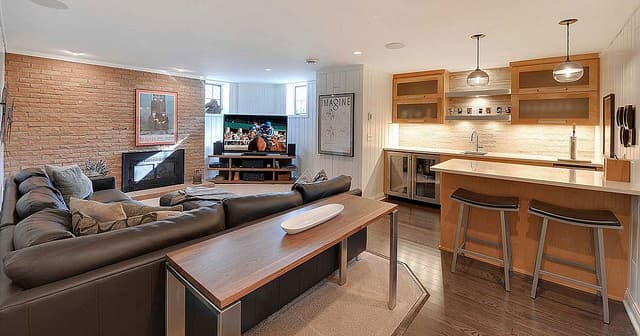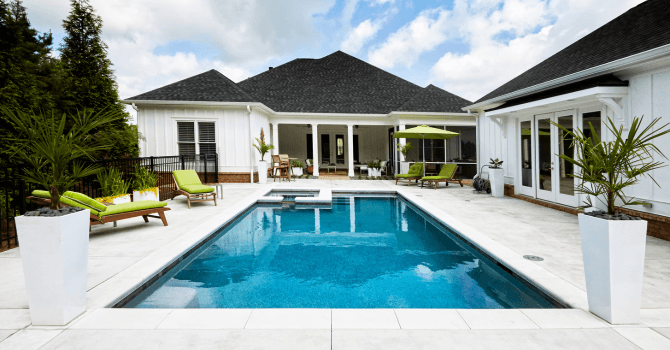Find the Ideal Metal Siding for Your Project
By Editorial Team
Updated on February 14, 2024

Having to choose between steel and aluminum can be quite a dilemma. Both materials have appealing characteristics, more so considering that solely their drawbacks can differentiate them. Our article is a handy guide to help you determine which material is the strongest match based on your needs.
Choosing the Right Metal Siding: Steel vs. Aluminum

The Benefits of Exterior Steel Siding
Galvanized steel is a type of steel that's hot-dipped into a tank of molten zinc to be made corrosion-proof by an electrochemical barrier. It has several advantages:
Averages a 60-year lifespan
Copes well with Northeast winters
Fire resistant
Can mimic wood
The Benefits of an Aluminum Siding Construction
Lifespan ranges between 30 and 50 years
Cheaper than steel
Provides a high degree of protection
Can take on a wood-like aesthetic
Non-flammable
Withstands insects and fungi
Recyclable
Of all types of siding considered, aluminum is the most abrasion-resistant. Factory-treated cladding is retailed in numerous shades (single-tone, anodized, wood-like), of which the paint also serves as a protective layer, shielding it from UV rays.
It withstands the test of time so efficiently, so much so that during its entire lifespan, it only ever needs to be repainted once.
Key Steps to Installing Metal Siding

Step 1: Choose tools and materials
To effectively install metal cladding over a structural surface wall, you have to gather at least 20 or so useful tools, such as:
Claw hammer
Folding ruler
Fine-tooth file
Aviation shears (double-acting)
Duckbill-type tin snips
2-foot level (minimum)
Steel measuring tape
Screwdriver
Chalk line
Snap-lock punch tool
Carpenter’s metal square
Utility knife
And more
The list doesn’t end here since you’ll still need to gather must-have metal cladding application materials:
Hot-dipped galvanized steel (or aluminum) nails
Aluminum breather foil
Mastic
Caulking (silicone or butyl sealant)
Trim
Step 2: Calculate the amount of siding needed
The wall surface of a standard house is made up of rectangles or triangles. Use the appropriate formula amongst the following:
Rectangle surface area = Base X Height
Triangle surface area = Base X 1/2 Height
Trapezoid surface area = Height X 1/2 of sum of parallel sides
Gable end surface area = Width X ½ Height
Dormer surface area = (triangle) Base X 1/2 Height
Then, measure the furring strips and include a 10% allowance to account for waste.
Step 3: Prepare the surface
Having levelled façade surfaces is one of the prerequisites for properly installing metal siding. Should you notice any depressions in the walls' surface, use shims to level out the area.
Secure with new nails all components that are entirely or partially unfastened and replace all rotten boards.
Lastly, scrape the existing caulking, hardened mastic, and build-ups of paint on the surface that is to be covered, and apply new caulking. Remove the downspout and tie back the shrubs that line the side of your façade so as not to damage them during the installation.
If you have exterior window jambs (window sills), cut them in such a way that the J-shaped metal trim (J-channels) aligns with the window frame.
Step 4: Install wood furring strips
The wood furring strips are used as an anchoring point for the new siding. These are ⅜-inch thick or 1” X 3” furring strips for either brick or masonry walls.
The furrings aren’t mandatory for new houses, as the structural walls are typically already smooth and straight. On the other hand, for older model homes with rather uneven walls, the furrings serve as a smooth and uniform base, one that’s mandatory to properly secure the new siding.
Step 5: Install the aluminum foil underlayment
The aluminum foil serves as an insulator due to its reflective component installed facing the air space. To secure it in place, it can be stapled directly to the existing wall or against the furring strips. The air space that’s then created provides better insulation for the house.
By using a perforated or “breather” aluminum foil, it ensures water vapour is properly evacuated. Said aluminum foils are commonly used during renovation work.
To prevent air leaks, make sure to overlap the joints and allow them to overhang the edges by 1 to 2 inches.
Step 6: Mark a straight reference line
Proper siding installation can be done using this reference line. To ensure the reference line is correctly established, ensure the line is parallel with the following features:
Eaves
Windows
Soffit
That way, even if your house has settled, your reference line will be straight. To do so, hammer in a nail 10 inches above the lowest corner of the house. Repeat that same step, but on the other side of the façade. Then, run a chalk line between the two nails, ensuring that the line created is taut and of equal distance between the measuring points we mentioned (eaves, windows, and soffit).
Once the lines are in place on all sides of the house and you’ve double-checked them using a level, you can snap the chalk lines to mark the surface.
Step 7: Install inside and outside corner posts
To shape the inside corner, you can install corner posts or two right-angle J-channels. Add a bead of caulking to prevent water from leaking through the juncture.
The inside corner post is used to cover the entire length of the corner, starting ¼-inch under the starter strip and extending to the eaves and gables.
Note that the nails located along the flanges shouldn’t be hammered in too deep, otherwise, they could warp the material.
The outside corner post is meant to receive the siding. These are installed just like the inside corner posts are. If there are corner posts installed already, you can go ahead and remove them.
Step 8: Install the siding
Using the straight chalk line as a reference—it lines up precisely at all corners—install the starter strip, ensuring it overlaps the corner posts’ nailing flanges. That way, you’ll mitigate air leaks.
The nailing flange should be nailed as close to the bottom as possible, without it bending or folding in any way. Using tin snips, cut lengths of starter strips, then butt the sections together.
Secure the other rows by ensuring the nails are inserted into wood that has been pre-drilled and is in good condition. Make sure to use plain shank nails when securing the panels to the house’s structure.
If you happen to anchor the metal siding to the plywood, avoid using plain shank nails, but instead ring or screw shank nails.
Why pick metal architectural panels?

We’ve already gathered that aluminum, just like metal, has genuine advantages. So much so that one still can’t pinpoint why metal would be better than aluminum.
Therefore, let’s focus on aluminum’s drawbacks, which are as follows:
Hard to repair
Loud (heavy rainfall, hail)
Prone to scratching
Not especially shock-resistant
In terms of covering a house, the above-mentioned can be real disqualifiers. However, metal, as well as in its galvanized form, isn’t drawback-free, since it’s:
heavy;
requires quite a bit of maintenance; and
prone to rusting.
Why does it rust? Rust occurs on account of various factors leading metal to no longer be protected by an ionic barrier provided by zinc, such as the following:
Harsh environment
Improper installation
Physical shocks
Long-term, which is, as we previously established, 60 years for metal, the latter may be more worthwhile for a home as it’s easier to repair in case of a problem.
Indeed, one never knows what a house may be exposed to over a 60-year period, post-construction. Between fallen trees as a result of strong winds and weather calamities, relying on something truly solid might just be the most rational choice.
Furthermore, with galvanized steel, one can often coat it with a layer of paint, thereby forming a thermoplastic fluoropolymer membrane, further protecting the metal.
Do steel panels act as insulators?

Whether it be steel or aluminum, neither material is an insulator. In fact, they’re a far cry from that. Here’s a chart detailing the minimum values that materials must possess to qualify as insulators, as well as the value attributed to steel and aluminum.
Minimum Insulation Value | Steel | Aluminum | |
Lambda (Thermal Conductivity) | 0.065 | 50 | 330 |
Thermal Diffusivity | 0.6 | 14 | 138 |
Thermal Effusivity | 200 | 13,247 | 28,001 |
Thermal Lag (8 in/20 cm) | 10 hours | < 2 hours | < 1 hour |
Naturally, steel or aluminum panels used as house siding or metal roofing have no insulation properties and don’t need to have any since standard insulation can be added behind this type of siding or inside the home.
However, there are insulated metal panels, also known as “sandwich panels.” It may be one of the following materials sandwiched between two metal panels:
Polyurethane (polyisocyanurate)
Rock wool
With factory-made sandwich panels, their core is typically made with injected or sprayed polyurethane foam (PIR) or glued-on rock wool.
Polyurethane is advantageous since it’s much more lightweight and cost-effective compared to rock wool. However, rock wool bypasses polyurethane when the panels solely present a fire resistance performance rating of A2 s1 d0.
Therefore, you can pick a metal siding for your house that’s both aesthetic and has insulation properties. As such, the panel will already have a minimum insulation value for above-ground walls of 4.31 RSI (R-24.5), which is the minimal value imposed by the Construction Code.
Prices and Other Factors Affecting Siding Costs

On average, aluminum is retailed between $7 and $10 per square foot.
As for steel, budget for $25 per square foot.
Just like with any other unprocessed materials, costs are likely to fluctuate. For aluminum, several factors affect its price based on the LME (London Metal Exchange).
Supply and demand
Production capacity
Economic climate
Investor behaviour
Product quality
Value of the dollar
Manufacturing, transportation, and insurance costs
As such, between the period of January 2023 ($2,488/ton) and December 2023 ($2,173/ton), prices fluctuated by $200, depending on the month. The LME forecasted a spike in costs (per ton), surpassing the $2,270 threshold before July 2024, potentially leading to a surge of up to $2,700 by December 2024.
Inflation also affects metal, and 2024 could see soaring costs, courtesy of Canadian steel plants. At the very least, this is what the RTMQ (Réseau de transformation métallique du Québec—a provincial metal processing network) predicted.
Exterior Siding Protection and Maintenance

Steel requires absolutely no maintenance. At most, you can always clean the sides of your house with a garden hose. Should you not have spare time to do so, you can always let Mother Nature (a.k.a heavy rainfalls) take its course.
The same goes for aluminum, which only requires a very basic maintenance routine. However, if you do want to clean it, you can use the following cleaning agent formula:
⅓ cup of household cleaner
⅓ cup of trisodium phosphate
⅓ cup of laundry bleach
Pour everything into 4 litres of water and mix all ingredients together. Beware of using an abrasive solution or dissolvent as either of these could damage the aluminum’s finish coating.
Choosing Your Metal Siding: Aesthetic and Highly Effective
Choosing the ideal metal siding suited to your project mandates a meticulous consideration of several factors, such as:
Aesthetics
Durability
Low maintenance
Energy efficiency
This article highlighted the specific characteristics of steel and aluminum to help you make a well-informed decision, meeting both your aesthetic vision and practical needs. Well-selected metal siding adds value to the overall visual appeal of your home, but also provides long-lasting protection against the elements.
Get 3 renovation quotes for your exterior siding project
RenoQuotes.com can help you get quotes for your exterior siding project. By submitting your project, we’ll put you in contact with top-rated contractors. Fill in the form on the homepage (it only takes a few minutes), and you will get estimates from trusted professionals.
Dial 1-844 828-1588 to speak with one of our customer service representatives.
Looking for something else?
Related articles
The latest industry news, interviews, technologies, and resources.

Léa Plourde-Archer
•24 Oct 2024
The French drain plays a highly important role in preserving your home's integrity, as water accumulating near the foundations can seriously damage a home and lead to expensive renovations.

Léa Plourde-Archer
•07 Nov 2023
Feeling like your house needs a makeover but you don't know where to start? Here is a list of 5 home improvement projects that will make your house look brand new.

Editorial Team
•05 Dec 2023
Storage space for some, unfinished room for others, yet thanks to its size the basement is a part of the house brimming with possibilities. Whether you’re ready to invest or get inventive, there is no limit to your comfort. Make your basement transformation a reality without having to quash your creativity.

Editorial Team
•23 Jul 2025
The summer season is approaching and you may be thinking about installing a swimming pool in your backyard to make the most of it! No doubt your loved ones and especially your children would be delighted with this addition. Of course, if you’re already imagining a pool in the backyard, whether you opt for an above-ground or underground model, it’s only natural to skip the hard parts and envision yourself drinking a poolside glass of lemonade.

Amanda Harvey
•07 Nov 2023
Walking into a cramped bathroom or a tiny kitchen is a familiar feeling for anyone who’s rented an apartment or shared a space with multiple roommates. As we grow older, we hope that our home will be a spacious, big and beautiful place.